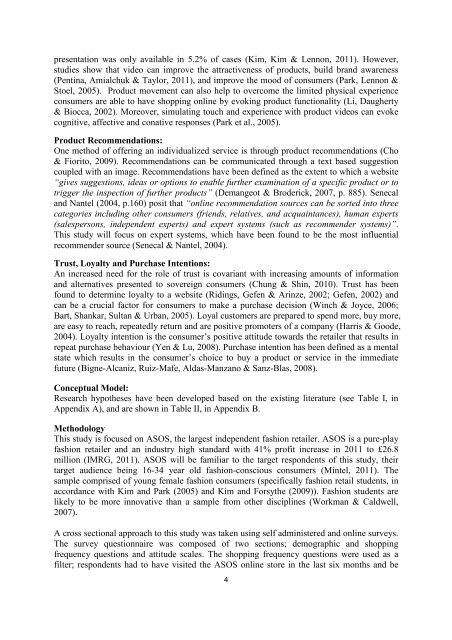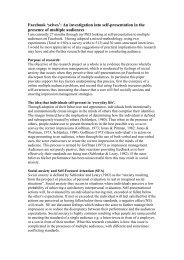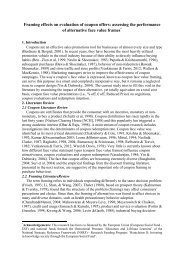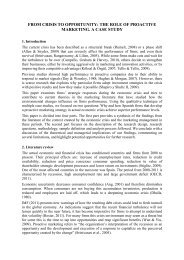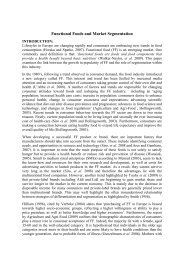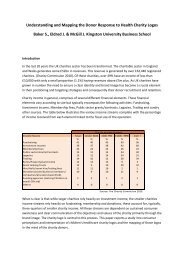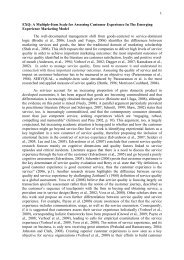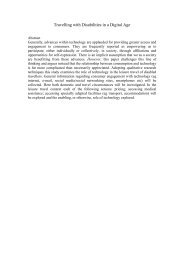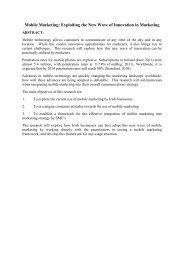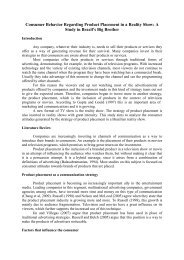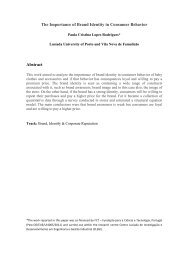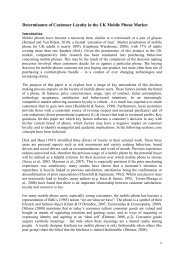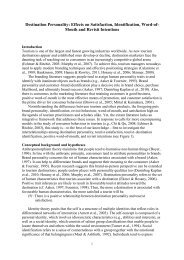Simulating Attachment to Pure-Play Fashion Retailers - Academy of ...
Simulating Attachment to Pure-Play Fashion Retailers - Academy of ...
Simulating Attachment to Pure-Play Fashion Retailers - Academy of ...
You also want an ePaper? Increase the reach of your titles
YUMPU automatically turns print PDFs into web optimized ePapers that Google loves.
presentation was only available in 5.2% <strong>of</strong> cases (Kim, Kim & Lennon, 2011). However,<br />
studies show that video can improve the attractiveness <strong>of</strong> products, build brand awareness<br />
(Pentina, Amialchuk & Taylor, 2011), and improve the mood <strong>of</strong> consumers (Park, Lennon &<br />
S<strong>to</strong>el, 2005). Product movement can also help <strong>to</strong> overcome the limited physical experience<br />
consumers are able <strong>to</strong> have shopping online by evoking product functionality (Li, Daugherty<br />
& Biocca, 2002). Moreover, simulating <strong>to</strong>uch and experience with product videos can evoke<br />
cognitive, affective and conative responses (Park et al., 2005).<br />
Product Recommendations:<br />
One method <strong>of</strong> <strong>of</strong>fering an individualized service is through product recommendations (Cho<br />
& Fiori<strong>to</strong>, 2009). Recommendations can be communicated through a text based suggestion<br />
coupled with an image. Recommendations have been defined as the extent <strong>to</strong> which a website<br />
“gives suggestions, ideas or options <strong>to</strong> enable further examination <strong>of</strong> a specific product or <strong>to</strong><br />
trigger the inspection <strong>of</strong> further products” (Demangeot & Broderick, 2007, p. 885). Senecal<br />
and Nantel (2004, p.160) posit that “online recommendation sources can be sorted in<strong>to</strong> three<br />
categories including other consumers (friends, relatives, and acquaintances), human experts<br />
(salespersons, independent experts) and expert systems (such as recommender systems)”.<br />
This study will focus on expert systems, which have been found <strong>to</strong> be the most influential<br />
recommender source (Senecal & Nantel, 2004).<br />
Trust, Loyalty and Purchase Intentions:<br />
An increased need for the role <strong>of</strong> trust is covariant with increasing amounts <strong>of</strong> information<br />
and alternatives presented <strong>to</strong> sovereign consumers (Chung & Shin, 2010). Trust has been<br />
found <strong>to</strong> determine loyalty <strong>to</strong> a website (Ridings, Gefen & Arinze, 2002; Gefen, 2002) and<br />
can be a crucial fac<strong>to</strong>r for consumers <strong>to</strong> make a purchase decision (Winch & Joyce, 2006;<br />
Bart, Shankar, Sultan & Urban, 2005). Loyal cus<strong>to</strong>mers are prepared <strong>to</strong> spend more, buy more,<br />
are easy <strong>to</strong> reach, repeatedly return and are positive promoters <strong>of</strong> a company (Harris & Goode,<br />
2004). Loyalty intention is the consumer’s positive attitude <strong>to</strong>wards the retailer that results in<br />
repeat purchase behaviour (Yen & Lu, 2008). Purchase intention has been defined as a mental<br />
state which results in the consumer’s choice <strong>to</strong> buy a product or service in the immediate<br />
future (Bigne-Alcaniz, Ruiz-Mafe, Aldas-Manzano & Sanz-Blas, 2008).<br />
Conceptual Model:<br />
Research hypotheses have been developed based on the existing literature (see Table I, in<br />
Appendix A), and are shown in Table II, in Appendix B.<br />
Methodology<br />
This study is focused on ASOS, the largest independent fashion retailer. ASOS is a pure-play<br />
fashion retailer and an industry high standard with 41% pr<strong>of</strong>it increase in 2011 <strong>to</strong> £26.8<br />
million (IMRG, 2011). ASOS will be familiar <strong>to</strong> the target respondents <strong>of</strong> this study, their<br />
target audience being 16-34 year old fashion-conscious consumers (Mintel, 2011). The<br />
sample comprised <strong>of</strong> young female fashion consumers (specifically fashion retail students, in<br />
accordance with Kim and Park (2005) and Kim and Forsythe (2009)). <strong>Fashion</strong> students are<br />
likely <strong>to</strong> be more innovative than a sample from other disciplines (Workman & Caldwell,<br />
2007).<br />
A cross sectional approach <strong>to</strong> this study was taken using self administered and online surveys.<br />
The survey questionnaire was composed <strong>of</strong> two sections; demographic and shopping<br />
frequency questions and attitude scales. The shopping frequency questions were used as a<br />
filter; respondents had <strong>to</strong> have visited the ASOS online s<strong>to</strong>re in the last six months and be<br />
4


